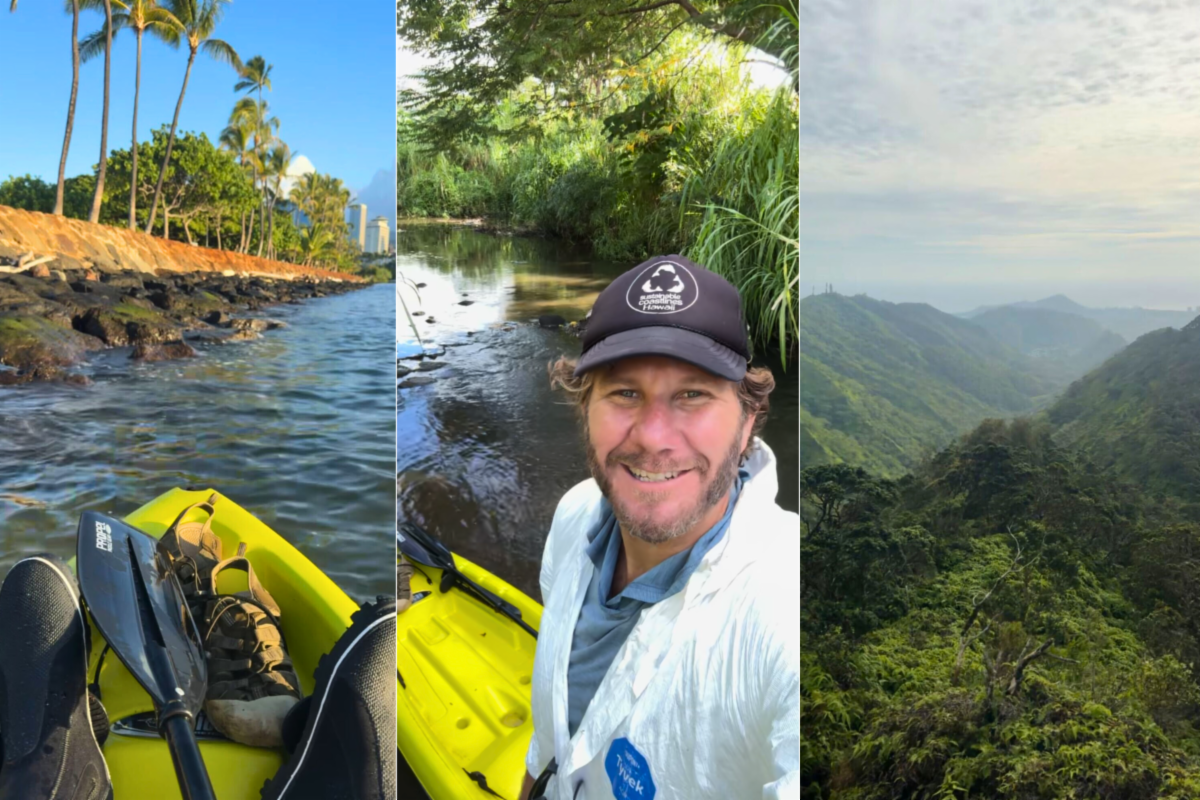
.jpg)
Did you know that Pālolo Stream is one of the major waterways within the Waikīkī ahupuaʻa? Its water sources begin in the Koʻolau Mountain range, high in Kaʻau Crater, where the Waiʻomaʻo and Pukele streams originate and later merge to form Pālolo stream. From there, the stream winds through today’s urban Honolulu, eventually emptying into the Ala Wai Canal and out toward the ocean near the man-made peninsula known as Magic Island.
This November, Sustainable Coastlines Hawaiʻi centered our large-scale cleanup and Island Earth event around Pālolo stream and the Waikīkī ahupuaʻa to deepen our understanding of coastlines and come together through acts of community care.

To help tell that story, our Executive Director, Raf, set off on a journey beginning makai at Magic Island, paddling in his kayak up the Ala Wai and into Pālolo Stream before hiking to the Kaʻau Crater. His day-long storytelling trek traced Pālolo streamʻs path back to its source, offering reflections along the way and showing, quite literally, how our land-based debris and consumer habits shape the health of our coastlines. We know Raf has a ton of reflections after this experience and weʻll be sharing more of his takeaways soon!
On November 8, volunteers joined us along three sections of Pālolo Stream from the Ala Wai Boat Harbor and up to Kaimukī for an all hands cleanup! Weʻre excited to keep the energy going this upcoming weekend on Saturday, November 15th, were we will be celebrating the cleanup with a free film screening of ʻAʻĀ by filmmaker, Chris Miyashiro and sharing more of our impact report from the cleanup.
.png)
Throughout November, we've also been working with our (re)learning team to learn more about the moʻolelo and history of the Waikīkī Ahupuaʻa. Here are a few things weʻve learned and encourage everyone to dig deeper into the history of where they live and the coastlines they call home.
Waikīkī Ahupuaʻa
When you hear the name Waikīkī, what do you think of? A tourist trap? A popular surf spot? While we commonly refer to Waikīkī today as a particular area between Lēʻahi (the iconic landmark seen from Waikīkī also known as Diamond Head) and Ala Moana, the name Waikīkī actually refers to an entire ahupuaʻa, a land division marked by the watershed that reaches from the mountains to the ocean.
Waikīkī is literally translated to “spouting water”, which may be hard to see today, but tells us about the abundance of water that was in this area when it was given this name. Waikīkī was once a wetland full of loko iʻa (fishponds) and loʻi kalo (taro patches), abundant with water birds and fish. However, as the area became attractive for development, starting with hotels, and the wetland was drained into the Ala Wai Canal, the landscape was transformed and many Kānaka Maoli (Hawaiian people) of these lands were displaced. Today, while Waikīkī is known as a commercial tourism epicenter, diving deeper into its rich history can help us look past what we see on the surface and create deeper connection to a place and its history.
Magic Island
Did you know that Magic Island is not an island? The area we call Ala Moana today was once riddled with loko iʻa (fishponds) along the coastline, and the place where Magic Island now stands was once just ocean. The ʻili ʻāina of this area is Kālia, literally translated to “waited for”. An ʻōlelo noʻeau describes the area: "Ke kai wawalo leo leʻa o Kālia": The pleasing, echoing sea of Kālia (Pukui). Before becoming the large shopping mall it is known as today, the wetlands of Ala Moana were filled and made into a garbage dump. “The Garbage Hole” was the local name of a surf spot where Magic Island now stands, named after the trash that would swirl in the water!
As the sea floor was dredged to make way for boats around the harbor, Magic Island was built from that dredged coral, along with burned trash from the garbage dump. While Magic Island was initially built to become an ocean-front resort, the funding fell through and it was made into a public park. Today, locals and tourists alike enjoy the beautiful greenery of Magic Island, unaware of the dredged coral and trash remnants that lie beneath their feet.
Sources
Wehewehe.org – Hawaiian language dictionary
Wiegel (2008), Waikīkī: A History – PDF hosted by Hawaiʻi DLNR
Images of Old Hawaiʻi – Kālia historical overview
Ala Moana Beach Park and ʻĀina Moana – Take Responsibility Blog
Pukui, Mary Kawena. ʻŌlelo Noʻeau: Hawaiian Proverbs & Poetical Sayings